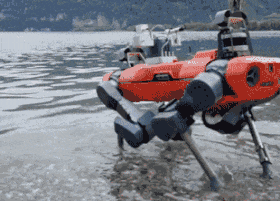ANYbotics has clearly demonstrated one of the main advantages of its four — legged robot ANYmal-protection from water according to the IP67 standard. During the tests, the robot was almost completely submerged in the water, walked on the rocks at the bottom and went ashore.
The active development of four-legged robots in the form in which they are now known began in the 2000s, when the us military became interested in them. They assumed that robosobaks will be able to carry equipment and ammunition without experiencing problems when walking on difficult terrain, for example, in the mountains. After several years of development and testing, the military still [...] abandoned this idea, but the resulting developments, mainly from Boston Dynamics, continued to be used, now in civilian four-legged robots, and not only from this company.
Last year, the Swiss company ANYbotics introduced the four-legged robot ANYmal, which is based on earlier research prototypes, but in a new version is intended for commercial use. He uses powerful servos in his legs for movement, which allow him to carry up to ten kilograms. For navigation, the robot uses lidar and several cameras, including infrared and rotary.
The main difference between ANYmal and the American Spot or Chinese AlienGo is that it is protected from water ingress according to the IP67 standard (diving to a depth of up to a meter lasting up to half an hour). Previously, the company only announced this possibility, and now it has demonstrated this in practice by launching a robot into a Swiss lake. During the tests, the robot went into the water at different depths, up to such a depth that only the camera block, the front part of the body and part of the lidar remained above the water. He moved through the underwater rocks and went ashore without any difficulties.
After testing, the developers showed charging the robot. The charger is a cone with contacts, on which the robot rests the back of the case with a recess. It takes three hours to fully charge.
In addition to commercial four-legged robots that are sold to order and cost tens of thousands of dollars, there are also open projects for those who want to build such a robot on their own and spend less money. Last year, American engineers presented one of these projects called Doggo. It consists of components that can be ordered from electronics stores, the total cost of which is about three thousand dollars.
Gregory Copies

